By Dan Shea
The Cibola Dust Course at Yuma Proving Ground is well known to small arms testers as a place that not only tortures the firearms, but the testers as well- with temperatures sometimes exceeding 115 degree (F), dust, and the merciless blazing sun over the Arizona desert. Every few years, Heckler & Koch GmbH comes from Oberndorf, Germany, and gathering their US counterparts and various government witnesses and testers, they arrive at this blistering hot range to try out their newest designs in this brutal environment. Tests are also done in jungles, temperate climates, oceans, and the arctic, but this month, it was to be the desert.
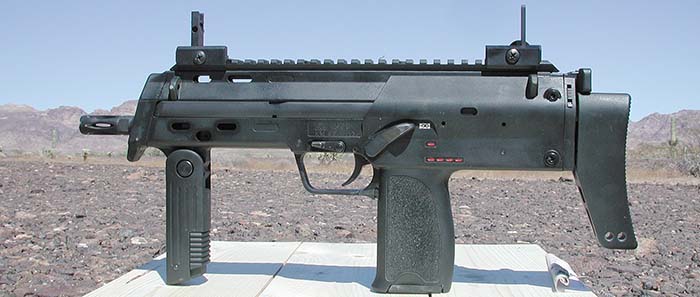
SAR had the opportunity to be there, as we have in the past, to try out HK’s newest items. Some of these we are not able to discuss with the readers yet, but rest assured that HK is out at the forefront again, innovating and challenging with new designs. When they tell me that we can tell you, then you, the readers will get the first look at some amazing new small arms.
One item that I did have a chance to openly test, was the newly adopted German army version of the HK PDW offering in 4.6 x 30mm, type classified as the MP7. We have some nice pictures of this weapon presented here, and some responses to the test. We will be doing a much more comprehensive test at a later date, when the US market is prepared to receive production models of the PDW- we’ll show you what is coming to the US LE and Military markets at that point.
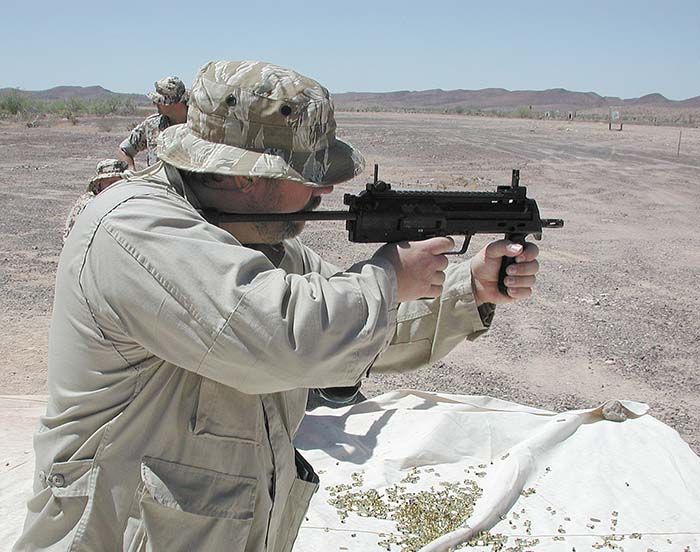
“Personal Defense Weapons”, “Individual Defense Weapons” and their similar named counterparts are intended to fill multiple roles. The fundamental idea is to arm troops that are not the basic infantry, so that they will have small, effective firepower to utilize if combat comes into their area. This means drivers, maintenance personnel, tank crews, artillery personnel, air crews, and the REMF group in general. Too often these soldiers and sailors are confronted with combat that they are unprepared for. One instance that comes to mind is the US Air Force personnel who were on the airbase in Da Nang during the Tet offensive in 1968. The US Marines were providing defense at the airbase, and the Air Force personnel were generally not armed, M16s were left in the armory. When the VC/ NVA forces overran the Marine defensive positions, it left the Air Force personnel unarmed, with the resultant loss of 18 aircraft and many lives. The lack of weaponry was from orders up the line, where certain officers viewed these military personnel as not being able to perform their jobs if they had to drag their rifles around with them. This policy cost a lot of lives, as well as lost equipment, and that unfortunate situation has been repeated countless times in armies around the world. An issue sidearm/ handgun was insufficient for fighting AK47 armed adversaries.
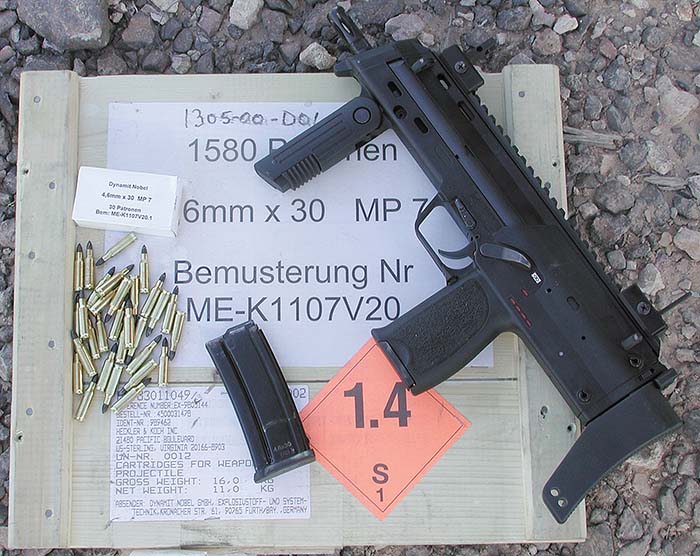
Giving these support troops a viable weapon is a wonderful idea- a weapon that makes them efficient in defense out to 200 meters, in a package small enough that it can be carried or kept at hand at all times.
Additionally, the MP7 lends itself to Special Operations due to its small size, controllability and probable lethality.
Typical of HK products, the MP7 worked flawlessly, and was smooth to operate. The readers would expect that the German engineers working on this project would not bring an offering to the table until they were fairly certain they had the bugs out and were fine tuning the project, and they would be correct in that assumption. There is, however, a more controversial question here than “Can HK produce a high quality, effective Personal Defense Weapon”. It has to do with the ammunition.
As readers of SAR are no doubt aware, controversy once again engulfs the small arms community. This article is not going to arbitrate a final agreement on it, but I think it is safe to say that if we view the results of steel plate firing and accept the ballistic evidence from HK, we can punch some holes in the side of the argument that is “Dissing” the new smaller cartridges like the FN 5.7 x 28mm and the HK 4.6 x 30mm. While the claims of both FN and HK are that their cartridges are very different, with different results, the “Old School” is lumping them together and saying that neither cartridge has the terminal ballistics necessary to be an effective combat arm.

Your faithful correspondent is here to say that while this may be an old argument, at the risk of being somewhat disrespectful to some very learned men, it is not necessarily true. We went through this with the “9mm vs 45 acp”, the “Magnum” debacle, and more to the point- in the “7.62 x 51mm Nato vs the 5.56 x 45mm” debate. The old school at that time argued that you needed a full thirty cal, with all of its burning propellant, to effectively kill the enemy. The first reports from Vietnam on the terminal ballistics of the new AR15 5.56mm cartridge were that the soldiers were shocked by the massive damage it did to the enemy. Contrary to the naysayers, this new, small cartridge was indeed effective, and at the range of engagement at 300 meters or less, the lighter weight of the 5.56 cartridge allowed carrying extra ammunition with the same combat load, which was a great advantage to the soldier.
Waxing poetic here, this author is fond of semi auto’s in 308 fired with aimed fire, full auto belt feds out to 1400 meters in 308, etc, etc, ad nauseum, but the fact remains that the M16’s 5.56 x 45mm cartridge has proven to be a workhorse- and a very effective battle round. It is a devastating round in full automatic, and very controllable with the proper firearm as a platform, and the proper training. All of this is contrary to what the conventional wisdom was at the time.
Just because something is new, does not necessarily make it better or worse. The factories that are making these new Personal Defense Weapon style firearms have a lot of very knowledgeable people working at them, and they wouldn’t be risking as much of an investment if they didn’t have faith in the end result. I have learned to listen to them, and to try and understand what they are saying before I say “The projectile is too small to be effective”.
The ballistics of FN’s 5.7mm offering are different from the ballistics of the new HK 4.6mm offering. While some are saying “They are both smaller and appear to have less energy”, that is not a scientific statement, and the two new cartridges are not on the same page because they are “Smaller”, so while I have some extensive test time on the 5.7 x 28 FN offering, we will leave this discussion simply to the 4.6 x 30 HK offering.
However, I do have to point out that there have been several terminal instances with both cartridges, and the reported results were impressive. We do not have the written reports at this point, but will bring them forward as they become public. As I write this, there is an LE incident with a 5.7 x 28, where the subject dropped on the first burst, and was totally incapacitated before expiring. Everybody goes home, except the bad guy.
The new HK 4.6 x 30mm round fires a 24.7 grain projectile at a muzzle velocity of just under 2400 feet per second. HK’s claim is that the basic copper plated steel projectile will not only penetrate all standard issue body armor (up to CRISAT specs of 1.6mm titanium and 20 layers of Kevlar), but it will have sufficient terminal ballistics after performing that job. HK has supplied graphics of ballistic gelatin testing that would bear out their claims.
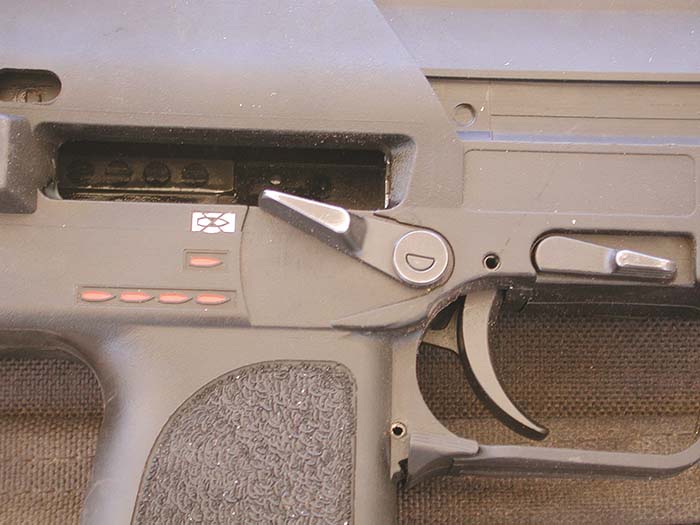
SAR’s conducted a steel plate test and this was the result: At 100 yards, the MP7 was controllable to the point of keeping long bursts on the target, and the penetration was impressive. I have little doubt that the penetration of typical body armor leaves sufficient energy to achieve HK’s claimed terminal ballistics, but that is something that time will tell about.

I fired about 350 rounds through the MP7 over the course of several days (there were lots of other interesting new firearms to be tested). Most of my firing was done at 100 meters, simply because that was where the steel plate was located.
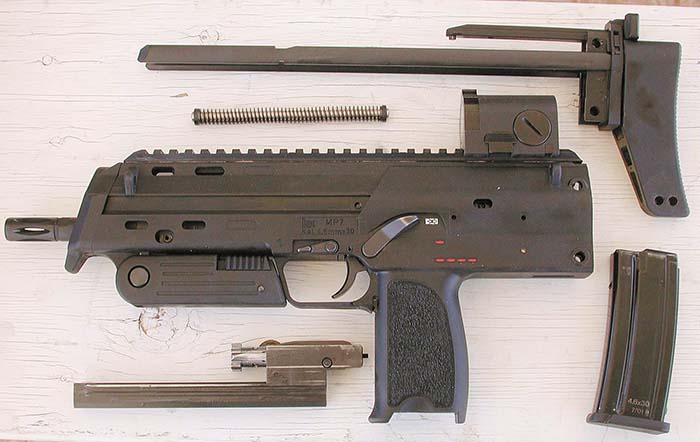
There are three basic firing positions that the PDW lends itself to: as a supported pistol, as an SMG from a two pistol grip at either the hip or extended arm, or as a shoulder braced SMG. All of my firing was done with a 20 round magazine, which would be the primary method of carrying the MP7 in a holster. This would keep the profile compact.
I tried to imagine the various roles that the MP7 might be called for, and starting with the “Drawn and fired as a handgun”, it performed well. The length extending over the rear of the pistol grip and out to the front will throw the shooter “Off” at first, until you get used to the idea- the MP7 is very lightweight, and balanced so that when held in the standard two handed firing position for a handgun, it is very controllable. I fired this position from semi auto only, and burst fire would be recommended for close range targets. In order to consistently hit the target at 100 meters, I used other methods. The reflex sight was very quick and simple to use in all positions.
Firing with the front pistol grip down, using both hands, but keeping the stock retracted, was an impressive SMG style package. Accuracy at long range went up, and I was most impressed with the “Nose”, meaning how compact the whole package would be for an entry team to use. When the firearm is too long, or has ergonomics that bend the wrists into unnatural positions so it must be kept out from the body when maneuvering through doors and other tight spaces, we say the “Nose” is off. This can be adversely affected on most firearms with the addition of a suppressor. While I did not get the opportunity to use a suppressor on the MP7, the ergonomics and small size of the MP7 lead me to believe that the suppressor would still be within a maneuverable package for Entry work.
Of course, my favorite was firing from the shoulder. My belief is that while we need to train for firing from every position, we should always try to get a solid shooting platform, and shoulder fired usually supplies that position. Adding the buttstock to the equation made for a good, solid support triangle, leading to increased controllability. This was evidenced by keeping all rounds on a 100 meter target. Very impressive.
Part of the reason for the good control is the recoil impulse of the 4.6 x 30 mm cartridge. There is a sharp recoil but the time is so fast that the recoil appears to be absorbed in the system, and the cyclic rate is tuned to the gun. Very controllable.
My take on the MP7? Well designed, well executed, and quite reliable in the tests. I saw it take a lot of abuse, and just keep on running. With a full 20 round magazine, at 3.8 lbs the MP7 is very handy, and with a holster will probably be kept with most troops instead of being left in the mess tent. The plan to keep the ammunition offered in the ten cents per round range is a good idea. I think HK has a winner on their hands, and as long as the terminal ballistics bear out the factory claims, the MP7/ HK PDW should be considered by most departments with tactical officers, as well as military support groups, and as a tool for Special Operations teams. SAR gives a thumbs up, and we look forward to bringing a much deeper look to the subject when HK is ready to start importing the PDW version for US use.
H&K PERSONAL DEFENCE WEAPON TECHNICAL DATA
Type of Weapon: Close-range weapon for all firing positions
Operating principle: Gas-operated weapon
Bolt system: positively locked, rotary bolt head
Calibre: 4.6 mm x 30
Modes of fire: Single and burst fire
Ammunition supply: Staggered magazines for 20 or 40 cartridges
Rate of fire: Approx. 950 rds/min.
Sight: Optical and mechanical sights
| This article first appeared in Small Arms Review V5N3 (December 2001) |










